WHAT'S NEW:
Deepsea Image Galleries on Multimedia page
(posted 9/15/98)
Eruption Confirmed!
New lava (rumbleometer stuck in flow) SE rift zone
(posted 9/1/98)
BACKGROUND:
Technology (ROV, ships, etc.)
Other 1998 Axial cruise reports
EXPEDITION:
Science Objectives
Calendar
Today's Science News
Participant Perspective
Teacher Logbook
EDUCATION:
Curriculum
Teacher Observations
Questions/Answers from sea
MULTIMEDIA:
(video clips, animations, sounds)
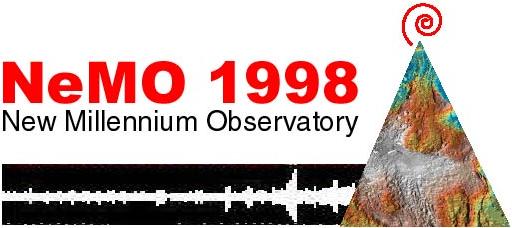
Logbook
September 15, 1998
September 15, 1998
Contents:
Science Report
Daily Science Report - Sep 15
ship's location = 45 56.0N/129 58.9W
ROPOS dive 478 returned to the upper south rift to deploy a
time-lapse
camera at the marker 33 vent, which will document changes at the site
over the next year. The rest of the dive consisted of coordinated SUAVE
chemical and biological sampling.
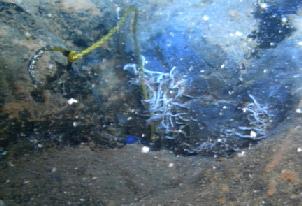 Tube worms were sampled from brand
new colonies (photo right shows "baby" tubeworms) on the new lava as well as pre-existing colonies on the
surrounding older lavas. The distribution of new animal communities at
vents on the new lava flow has been an intriguing aspect of the cruise.
Each vent seems to have a distinct assemblage of animals, and the
biologists are developing ideas about why this might be. Since new
colonies get started by the large numbers of drifting larvae, why don't
all the new vents get about the same number and kinds of species? Is
the biology of each vent dependent on the specific chemistry of the vent
fluids, or does the first arrival stake out a site and keep other species away?
Tube worms were sampled from brand
new colonies (photo right shows "baby" tubeworms) on the new lava as well as pre-existing colonies on the
surrounding older lavas. The distribution of new animal communities at
vents on the new lava flow has been an intriguing aspect of the cruise.
Each vent seems to have a distinct assemblage of animals, and the
biologists are developing ideas about why this might be. Since new
colonies get started by the large numbers of drifting larvae, why don't
all the new vents get about the same number and kinds of species? Is
the biology of each vent dependent on the specific chemistry of the vent
fluids, or does the first arrival stake out a site and keep other species away?
After the dive we recovered two of the three transponders that that we will no longer be using on the south rift zone.
Listing of all Science News postings
Life at Sea: Participant Perspective
Damien Grelon and Christian Levesque
University of Quebec Montreal

Who said a desert needs to be hot and dry? The bottom of the deep sea is a desert just like the Sahara. It's a dark and cold place, so dark that no organism can use photosynthesis to grow and become food to other organisms. You might know that most life on our planet is sustained by photosynthesis - the fixation of carbon dioxide by plants, algae and other photosynthetic organisms, using sunlight. These so-called "primary producers" grow by using carbon dioxide, water, inorganic nutrients and sunlight - that's all they need to live a happy life! They are then eaten by all sorts of animals (maybe not that happy a life, after all...), which in turn are used as breakfast by bigger animals and so on. Therefore, one might say that all life on Earth is ultimately supported by the energy coming from the sun.
But in the late 70's, scientists discovered an oases on the ocean-floor, thriving with a horde of bizarre creatures! (Well, you might have guessed that at some point, I was going to talk a bit about hydrothermal vents!) The question that immediately came to mind was: what do these organisms eat?
In the absence of sunlight and plants, the animals living in these deep-ocean resorts can be anything but vegetarians. Bacteria play there the same role as plants on terra firma - the role of primary producers. Instead of using light, these bacteria use chemical energy to fix carbon for growth. These microscopic "bugs" are absolutely fond of nasty chemicals that are toxic to us and most organisms - like hydrogen sulfide, which is responsible for the bad smell of rotten eggs. (To the best of my knowledge, the only organisms known to appreciate this stinky "fragrance" are these little bugs and some of the microbiologists onboard the R/V Brown who culture them and thus might get addicted to their emanations! But that's another story...)
Some of these amazing microbes live inside animals such as vestimentiferan tube worms and giant clams. This type of association, called symbiosis, means that the microorganisms produce food for their host animals, which in turn provide the little bugs with a shelter where they can live with all what they need (the condo-type deep-ocean housing...). Other 'sulfide-loving' bacteria prefer to live a free life in the water around vents or at the surface of rocks and organisms in the neighborhood. These little bugs can then be grazed by animals like snails, limpets and some polychaete worms, which in turn are eaten by carnivores like spider crabs and nereid worms. Food webs just like those on land, except that here, plants are replaced by microorganisms!
The exact way these unusual types of food webs work is still a mystery. Remember that hydrothermal vent communities have been discovered just over 20 years ago, and that doing research to understand their tricky mechanisms is not an easy job!
That might be exactly why Damien and I ended up doing this kind of work! But I've said enough for now and I'll let Damien tell you more about that!
Christian
It's not an easy job, that's true. Observation and sampling take much more time there than on land. To look at what's going on at the bottom of the sea we're using a ROV (Remotely Operated Vehicle) that is flying over the sea floor at a depth of 1500 meters. Hours and hours of fun... During the dives we try to find worms growing near the vents to observe their behavior and later bring them to the surface to analyze them. To look at their behavior we're doing in situ observation and we need to put the submarine very close to the vent. Furthermore we need to sample the worms and their food (bacterial mats.) without destroying the whole surface, and sometimes the samples don't exceed 0.5 cm in size. But the ROPOS' team manages to do some exploitation with this submarine. They even brought us to live worm combats and these fights are very new observations. We have to understand why they do it.
Who are we ?
We are two graduate students working with Kim Juniper at the University of Quebec at Montreal. Christian is trying to find out feeding relationships within hydrothermal vent food webs by doing isotope analysis of carbon and nitrogen. During this cruise he is mostly interested in the biology of two hydrothermal vent polychaete worms, Paralvinella palmiformis (the "palm worm") (red animals, top photo) and Paralvinella sulfincola (the "sulfide worm") (orange animals, bottom photo)
|
What Christian is looking at is how these species share resources in a way that allows them to coexist. So, he is collecting specimens of these species along with bacterial mats and suspended organic matter. But he couldn't resist the temptation to bring up other animals like scale worms, limpets and vestimentiferan tube worms to eventually look a little closer at their feeding habits. As for me, I'm studying the behavior of Paralvinella sulfincola and Paralvinella palmiformis. The first one lives very close to the hot fluid source where life is precarious. That's the one that fights (bad guy). The second species has both grazing and suspension-feeding behaviors, which is unusual. Their behavior seems to be different at each site. So I want to know if their behavior depends on where they live and if it is related to food resources or physico-chemical conditions. To complete my research I'm looking at their food sources in terms of kind of bacteria and amount. Damien |
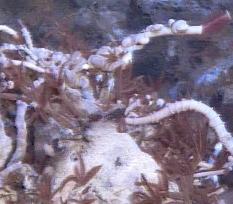
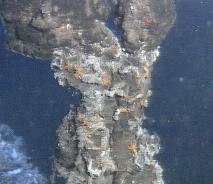
|
Listing of all Perspectives postings
Teacher At Sea Logbook
September 15- 0900 hours
Score- Lava flow 1, Scientists 0
You can read the details in the daily science report (see 9/14 Science News), but the short form is that 2200 pounds of pull from the ship's winch could not break the rumbleometer loose from the lava flow in which it was trapped. With that amount of tension on the line, the weak link in the cable snapped. Subsequent inspection with the ROPOS showed that the rumbleometer had not budged. The camera cannot see in under the rumbleometer, but it seems like a good bet that lava may be covering the railroad wheel anchor, and may even have sealed the release mechanism in solid rock. While there are some other possibilities for freeing the instrument, it is unlikely that another attempt will be made on this voyage.
Here's something for you to think about. Send us a suggestion for how we could free the rumbleometer from the seafloor. Remember that we want to release it without destroying the data it has collected. Dynamite is out of the question. It may help you to look back at the picture of the stuck rumbleometer, but someone out there probably has a real good idea that hasn't been thought of out here. The scientists would like to have a few new ideas about now. Maybe you'll be famous. . .at least with the crew of the R/V Brown.
We knew things were going too well to be true. Over the past three days we have had a variety of small things and large things go wrong with the ROPOS or the instruments it carries. After a successful retermination yesterday, ROPOS was back in the water at about 1700, but back out again a few hours later when the usually reliable SUAVE developed a problem and had to be brought back to the ship. It was a quick turn-around and this morning ROPOS is back on the seafloor working to complete the final goals of this expedition. Time is really getting short. Every scientist would like to get just a few more samples or an extra set of data points, and who can blame them. For most it will be at least another year before they can return to the observatory. The weather has cooperated. Our big gale turned out to be maximum winds of 16 knots, and this morning I can hardly feel the ship moving.
2000 hours
Great day today!! Fabulous tube worm fields, some of the largest I have seen anywhere on the expedition. We worked right along the edge or the new lava flow. The point where new lava meets the old ocean floor is called the contact. We have spent a considerable amount of time mapping the edges of this flow and looking at the effects it has had on the ocean floor next to it. Today we found a tube worm "barbecue", a spot where a colony of tube worms was partially covered and of course killed by the hot lava. We also found and sampled what Dr. Tunnicliffe and extremely important population of tube worms growing on top of the new flow. Since this lava is only about seven months old, the biologists will have a much clearer picture of the growth rates of both individuals and communities of tube worms.
SUAVE is working fine again and the fluid sampling around vents proceeds at an
unprecedented pace. ROPOS made a scheduled return to the ship this afternoon
and is currently being fitted with the instruments that will be used on the dive
later this evening. The goals tonight are to do some sampling of high
temperature vents at Ashes and then to investigate some tantalizing hints of
perhaps more unexplored vent fields south of the previous dive areas.
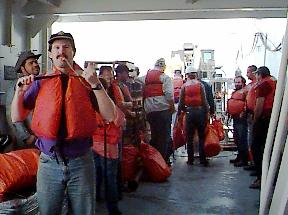
I haven't lost track of the head question. I don't want to put the answer up too quickly. Look for a photograph and an explanation tomorrow. Here's a couple of small hints. First, other heads will meet a similar fate in the near future. Second, it has nothing to do with the high powered microwave ovens found aboard the Brown. Those are used to burn bags of popcorn. It's a long story, and for Julia's sake I won't go into details here. At least we didn't have to abandon ship! (photo left shows a Safety Drill)
Logbook of all Teacher At Sea postings
Question/Answer of the Day
Send Your Question to NeMO
(oar.pmel.vents.webmaster@noaa.gov)
Back to Calendar